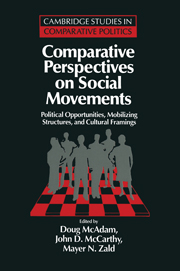 Comparative Perspectives on Social Movements
Comparative Perspectives on Social Movements Book contents
- Frontmatter
- Contents
- Biographical sketches of contributors
- Preface
- Introduction: Opportunities, mobilizing structures, and framing processes – toward a synthetic, comparative perspective on social movements
- PART I POLITICAL OPPORTUNITIES
- PART II MOBILIZING STRUCTURES
- 6 Constraints and opportunities in adopting, adapting, and inventing
- 7 The organizational structure of new social movements in a political context
- 8 The impact of national contexts on social movement structures: A cross-movement and cross-national comparison
- 9 Organizational form as frame: Collective identity and political strategy in the American labor movement, 1880–1920
- 10 The collapse of a social movement: The interplay of mobilizing structures, framing, and political opportunities in the Knights of Labor
- PART III FRAMING PROCESSES
- Notes
- References
- Index
9 - Organizational form as frame: Collective identity and political strategy in the American labor movement, 1880–1920
Published online by Cambridge University Press: 05 June 2012
- Frontmatter
- Contents
- Biographical sketches of contributors
- Preface
- Introduction: Opportunities, mobilizing structures, and framing processes – toward a synthetic, comparative perspective on social movements
- PART I POLITICAL OPPORTUNITIES
- PART II MOBILIZING STRUCTURES
- 6 Constraints and opportunities in adopting, adapting, and inventing
- 7 The organizational structure of new social movements in a political context
- 8 The impact of national contexts on social movement structures: A cross-movement and cross-national comparison
- 9 Organizational form as frame: Collective identity and political strategy in the American labor movement, 1880–1920
- 10 The collapse of a social movement: The interplay of mobilizing structures, framing, and political opportunities in the Knights of Labor
- PART III FRAMING PROCESSES
- Notes
- References
- Index
Summary
Modern society, according to Max Weber, is characterized by the displacement of a rationality of ends by a rationality of means. To date, much of social science has failed to pursue the implications of this claim. The study of ideology remains dominated by a vocabulary of ends, with its emphasis on substantive content, although attention to genre in discourse has begun to intrude on the margins of social history. The analysis of action continues to reference material interest in an endlessly elaborated system of class fractions and contradictory locations, although it is acknowledged that a few idiosyncratic groups such as professionals may have an interest in specific forms of social organization. For the most part, however, means are discussed in terms of presence or absence, resources in terms of more or less. The “how” of organization remains secondary to the “for what?” and “for whom?”
This claim may seem overstated, particularly in the field of social movement theory, where resource-mobilization approaches have been criticized for overemphasizing the mechanics of mobilization at the expense of the questions of collective identity that are central to the new social movement perspective (Klandermans and Tarrow 1988). But if one looks more closely, the role attributed to organization in movements has been conceived quite narrowly. Frequently, organization is conceptualized in rudimentary terms: present or absent as a facilitating or blocking condition (e.g., indigenous organizations and preexisting ties, McAdam 1982; Connell and Voss 1990); more or less as a resource (McCarthy and Zald 1977); bureaucratic or not as a possible limit on the radical potential of a movement (see Jenkins 1977).
- Type
- Chapter
- Information
- Comparative Perspectives on Social MovementsPolitical Opportunities, Mobilizing Structures, and Cultural Framings, pp. 205 - 226Publisher: Cambridge University PressPrint publication year: 1996
- 77
- Cited by


